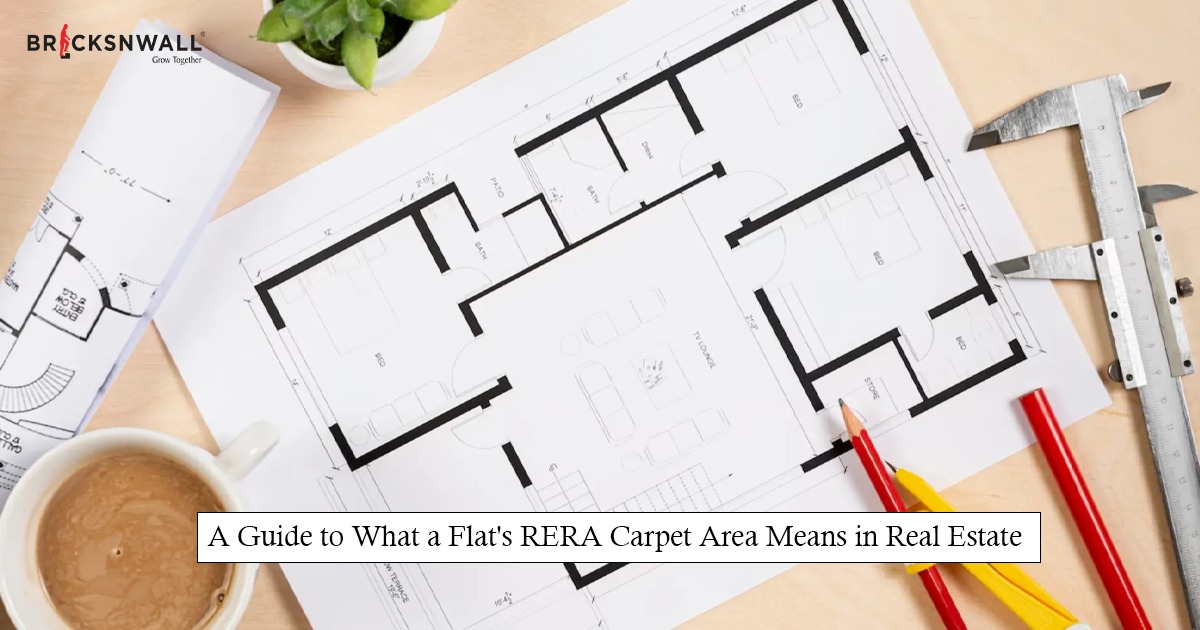A Guide to What a Flat's RERA Carpet Area Means in Real Estate
Bricksnwall Trusted Experts

The Real Estate (Regulation and Development) Act of
2016 (RERA) strengthened accountability and transparency in Indian real estate
by requiring carpet area to match actual usable space. within an apartment.
Unlike built-up areas, RERA carpet areas show customers the exact space they
would be purchasing. This article compares carpeting and built-up regions to
help you make informed real estate decisions. Whether you intend to buy, rent,
or create a home, read on to learn what RERA carpet area means and how to
measure carpet area before making a real estate investment.
When buying real estate in India, one of the most important things for potential homeowners to comprehend is the RERA carpet area definition. The Real Estate (Regulation and Development) Act of 2016 defines the "RERA carpet area" as the actual space available to a prospective buyer within an apartment or building.
The RERA carpet area excludes spaces occupied by external walls, regions beneath service shafts, exclusive balconies or verandas, and exclusive open terraces. As a result, if a building has two-bedroom units with balconies and terraces, RERA requires that the carpet area include just the usable space within the four walls. Lobbies, staircases and lift shafts will not be counted.
There is a large disparity between the RERA-defined
carpet area and the built-up space. The built-up area includes the space
beneath amenities like staircases, lifts, and lobbies, as well as the thickness
of internal and exterior walls. So, for example, if a two-bedroom house has a
built-up size of 1,200 square feet, the actual carpet area may be just 1,000
square feet under RERA rules because the external wall thickness and balcony
area are omitted.
The RERA requirements require developers to expressly mark the carpet and >. This gives consumers information and helps them to precisely predict how much valuable space they will obtain in exchange for their investment.
Importance of the RERA Act of 2016
The Real Estate (Regulation and Development) Act of
2016, also known as RERA, has changed India's real estate industry. The
following are some key characteristics that highlight the significance of this
legislation:
encourages transparency and efficiency
Promoters are required to register and disclose various
project information, such as layout plans, permissions, and dates. This
promotes crucial transparency.
To enhance efficacy, promoters should keep 70% of
project funds in dedicated bank accounts.
Protects homebuyers' interests
Before making significant renovations, builders must have two-thirds of the allottees' approval.
To safeguard consumers from fraud, provisions are
made for incarceration and punitive punishments.
Improves investor confidence
- Adequate verification prior to project
registration contributes to increased legitimacy.
- A specialised, quick dispute resolution
procedure increases investor confidence.
- A five-year period of accountability for
errors and a provision for clear title instill trust.
Provides accountability
- Real estate projects are closely overseen by
state regulatory agencies.
- The builder is responsible for ensuring
high-quality construction and on-time completion.
- Additionally, agents are responsible for
maintaining overall responsibility.
What's the distinction between carpeted and RERA carpet areas?
Homebuyers should be aware of the RERA carpet area
and the standard carpet area since both are important aspects to consider when
evaluating a home. Though they may sound similar, they have significant
variances.
The word "carpet area" refers to the
total usable space within the apartment's borders. The interior partition wall
space is also taken into consideration. Thus, in a structure with two BHK
flats, the carpet area will extend beneath each building's inner wall. Exterior
walls, balconies, and common areas such as stairwells, lifts, and lobby spaces
are exempt.
In contrast, the RERA carpet area relates to practical
space and excludes internal wall portions. Simply said, it refers to the
portion of the structure that is physically carpeted and can be laid wall to
wall. As a result, if a two-bedroom structure has 900 square feet of carpet
space, the RERA carpet area may be 855 square feet (5% less) due to the reduced
internal wall thickness.
The main difference between carpet area and RERA carpet area is the presence or lack of interior wall space.
While both convey a sense of usable space, the RERA carpet area gives buyers a more accurate indication of how much space they can use within a unit for furniture, carpeting, and so on. As a result, it is preferable to thoroughly evaluate both metrics rather than depending solely on built-up areas in order to avoid unpleasant shocks about actual utilisation in the future. During the on-site assessment of model constructions, subtract 5-10% of the carpet surface to determine how much RERA carpet space you can use.
RERA Carpet Area Formula
The RERA carpet area computation for determining
this crucial quality is as follows, according to RERA regulations:
RERA Carpet Area = Apartment's Net Usable Area + Internal Partition Wall Areas.







